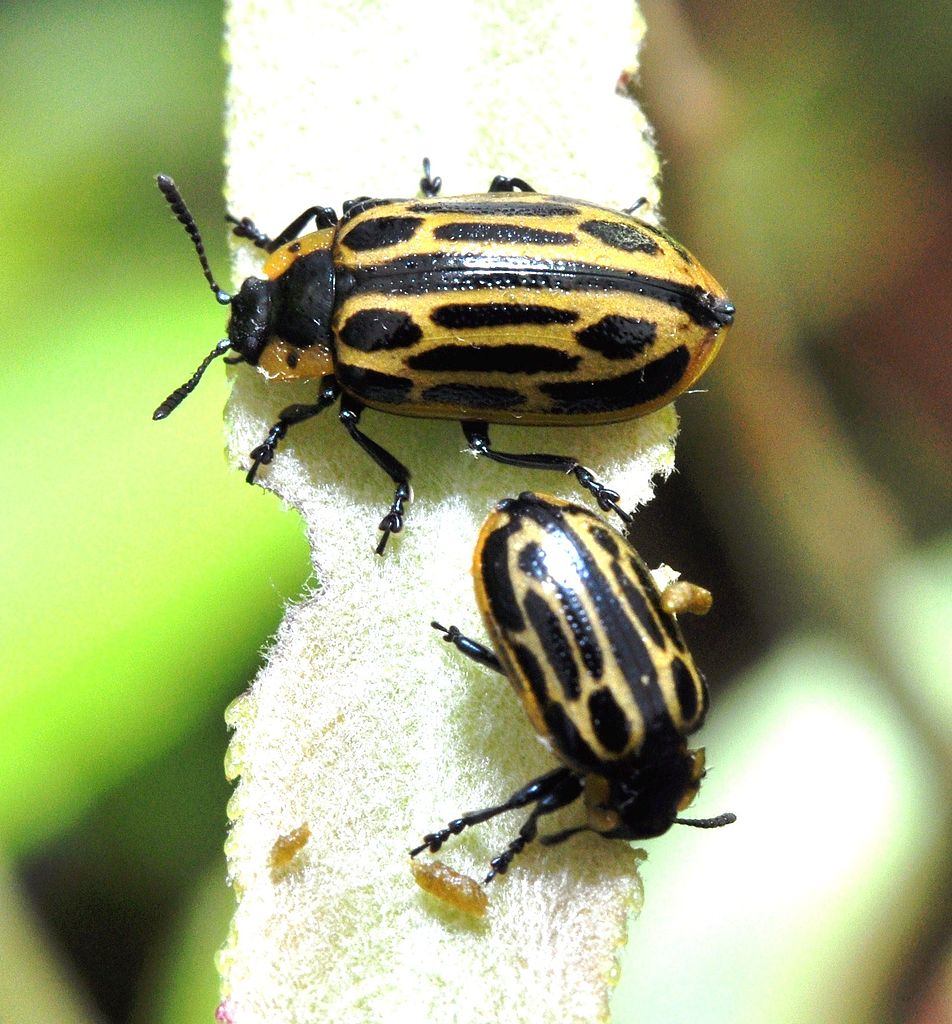Introduction
Cottonwood leaf beetle (Chrysomela scripta) is a significant defoliator of aspen, cottonwood, poplar, and willow. The insect is a native pest that occurs throughout the United States. While it seldom impacts forests, it can decimate vulnerable trees in landscape settings. Severe infestations often cause extensive foliar loss. This drastic reduction in foliage inhibits plant growth. Successive defoliations may result in plants becoming structurally unstable, rendering them prone to collapse.
Distribution & Habitat
The range of cottonwood leaf beetle extends throughout the United States, including Alaska. It is especially prevalent in locations where cottonwood, poplar, or willow are present.
Hosts
Cottonwood leaf beetle infests alder, aspen, cottonwood, poplar, and willow. Throughout the United States, eastern cottonwood is the insect’s preferred host.
Description
The adult females lay yellow eggs in clusters of 15 to 75 on the underside of foliage. When they first hatch, the larvae are black to gray. As they mature, the larvae turn light to dark brown. The larvae are covered with characteristic white scent glands that appear as spots. Mature larvae vary from gray to black in coloration. Fully grown larvae may extend up to 12 mm in length. The adults measure around 6 mm long. The females tend to be considerably larger than the males. The adults are oval shaped, with a black head, and black antennae. The insect’s elytra are yellowish with irregular black stripes. The thorax is mostly black, with several yellow or reddish margins.
Life Cycle
Cottonwood leaf beetle passes through four stages during its life cycle: an egg stage, a larval stage, a pupal stage, and an adult stage. The insect produces two or more generations per year. The adults overwinter in bark crevices, leaf litter, and other debris. In spring, as leaf expansion commences, the beetles emerge and initiate feeding on the most tender buds and leaves. During this period, the adults mate. Upon mating, the males expire, and the females begin depositing clusters of small, yellow eggs on the foliage of host trees. The eggs hatch one to two weeks later, revealing masses of tiny, black larvae.
The larvae are amiable creatures. They often establish communal groups that feed together throughout much of their development. As the larvae grow older, they become solitary feeders. When abundant, the larvae can rapidly skeletonize leaves. Older larvae will often consume entire leaves, with the exception of the larger leaf veins. If disturbed, the larvae will emit a pungent odor, which is intended to ward off predators. After one to two weeks of feeding, the larvae reach maturity. Once mature, the larvae assume an inverted position, and suspend themselves from leaves, bark crevices, and weeds, where they become sessile, and initiate pupation. The larvae pupate for five to ten days, whereupon they emerge as adults. The adults overwinter, and resume activity the following spring, beginning the cycle anew.
Symptoms of Infestation
The egg clusters, larvae, and adults may be observed on infested foliage throughout the growing season. As the larvae feed, they skeletonize the underside of leaves. Brown patches will often form on infested foliage. When the adults feed, they gnaw holes in the leaves, gradually devouring them whole. Only the larger leaf veins are left intact. This causes the leaves to develop a tattered appearance. The persistent feeding of the insects eventually disrupts the tree’s photosynthetic process, inhibiting its growth. Trees that are repeatedly defoliated will often experience extensive foliar dieback. If beetle populations are dense, some trees may succumb to infestation.
Management
- Weed management is integral to suppressing cottonwood leaf beetle. Weeds should be removed prior to winter, when the insects are still active.
- Several natural enemies help to reduce cottonwood leaf beetle populations, including the stink bug, Stiretus anchorago, the convergent lady beetle, Hippodamia convergens, and the v-marked lady beetle, Neoharmonica venusta, as well as various ants, spiders, and parasitic wasps. The convergent lady beetle feeds on the eggs, while the stink bug preys on the adults.
- Microbial and chemical insecticides can be employed to eradicate the insects. Insecticides must be applied before the larvae have entered pupation.
- Horticultural oils are effective at smothering the larvae. Applications should be performed in late spring or early summer, when the larvae are most abundant.
Photo courtesy of Pavel Kirillov CC-by-2.0


